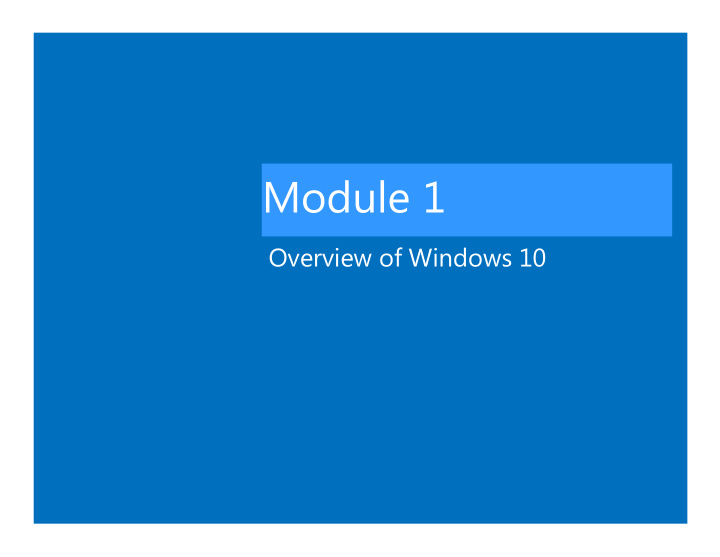



Module 1 Overview of Windows 10
Module Overview • Introduction to Windows 10 • Implementing Windows 10
Lesson 1: Introduction to Windows 10 • Overview of New Windows 10 Features that Increase Business Productivity • New Features of Windows 10 • Windows 10 Features not Available with the Initial Release • Demonstration: Exploring the new User Interface (UI) of Windows 10
Overview of New Windows 10 Features that Increase Business Productivity
New Features of Windows 10
Updating and Maintaining Management Choices Identity Management Updates Infrastructure Ownership Active Directory Group Policy Windows Update On-premises Corporate-owned Azure Active System Center Windows Update In the cloud CYOD Directory Configuration for Business BYOD Manager Windows Server 3rd party PC Update Services management (WSUS) Intune Intune 3rd party MDM 3rd party MDM Organizations may mix and match, depending on their specific scenario
Security Enhancements
Windows 10 Features not Available with the Initial Release The following announced features of Windows 10 will be made available over time through Windows as a Service. • Simplified Microsoft Passport Deployments. • Data Leakage Prevention (DLP). • Windows Store for Business.
Demonstration: Exploring the new User Interface (UI) of Windows 10 In this demonstration, you will see how to: • Know the key features of the new Windows 10 UI • Use the new Start Screen and Menu • How to configure and use Cortana • Use Action Center functionality • Use IE 11 and the new Edge Browser • Configure and use the new mail and calendar universal app • How to use Task View and multiple desktops • Enhanced SNAP Feature
Lesson 2: Implementing Windows 10 • Windows 10 Desktop and Tablet Editions • Windows 10 Hardware Requirements
Windows 10 Desktop and Tablet Editions
Windows 10 Hardware Requirements Windows 10 minimum Hardware requirements for Desktop: • Processor: 1 GHz or faster • RAM: 1 GB (32-bit) or 2 GB (64-bit) • Free hard disk space: 16 GB • Graphics card: Microsoft DirectX 9 graphics device with WDDM driver
Windows 10 Requirements for Mobile Hardware Windows 10 requirement for Mobile hardware: • Minimum 3 inches screen • Memory: 512 MB for 32-bit OS • Storage Space: 4GB • Graphics: DirectX 9 • 512MB of RAM for FWVGA (854x480 pixels) and WVGA (800x480 pixels) resolution devices • 1GB of RAM for WSVGA (1024x600 pixels) devices, HD (1280x720 pixels), WXGA (1366x768 pixles), and qHD (960x540 pixels) devices • 2GB of RAM for full-HD (1920x1080 pixels)
Support for Hardware Enabled Security
Why Trusted Platform Module (TPM) 2.0 • The VBS implementation of root key protection exists only for TPM 2.0 • Microsoft Passport works only if TPM 2.0 is present, TPM 1.2 are blacklisted due to reliability and performance • Device Health Attestation requires EK certificates, widely available in TPM 2.0 but only a handful of EK certs in TPM 1.2 • TPM 1.2 only supports SHA-1, which is on the path for deprecation
Systems Support for Windows Hello Windows Hello Facial Feature Recognition • RealSense Device • Lenovo Yoga 15 • Dell Inspiron 15 • HP Envy 15 • Intel RealSense Dev Kit • Fingerprint Recognition • Most Windows 8/8.1 Devices • Lenovo ThinkPad Carbon X1
Module Review • Review Question(s)
Recommend
More recommend